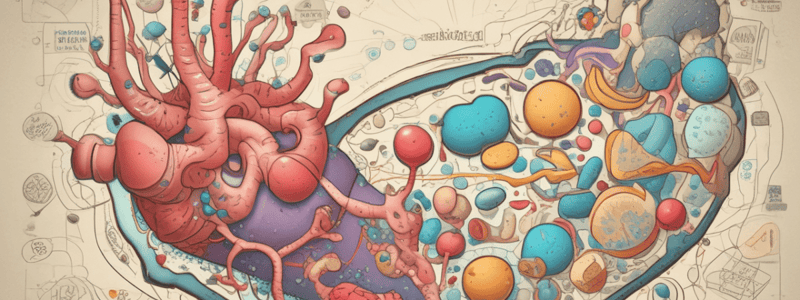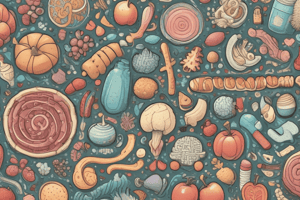Podcast
Questions and Answers
What is the basis of naming monosaccharides?
What is the basis of naming monosaccharides?
- Functional groups and number of carbon atoms (correct)
- Chemical properties
- Optical activity
- Structural formula
What is the term for a carbon atom that has four different groups bonded to it?
What is the term for a carbon atom that has four different groups bonded to it?
- Optically active carbon
- Asymmetric carbon
- Chiral carbon (correct)
- Stereoisomeric carbon
What is the energy yield from one gram of digested carbohydrate?
What is the energy yield from one gram of digested carbohydrate?
- 6 kcal
- 5 kcal
- 3.5 kcal
- 4 kcal (correct)
What is the simplest carbohydrate that exhibits chirality?
What is the simplest carbohydrate that exhibits chirality?
What is the recommended daily caloric intake from carbohydrates according to the USDA?
What is the recommended daily caloric intake from carbohydrates according to the USDA?
What is the purpose of a Fischer projection in representing monosaccharides?
What is the purpose of a Fischer projection in representing monosaccharides?
What is the basic formula for a monosaccharide?
What is the basic formula for a monosaccharide?
What is the term for nonsuperimposable mirror images of a molecule?
What is the term for nonsuperimposable mirror images of a molecule?
What is the molecular formula of glucose?
What is the molecular formula of glucose?
What is the bonding type between two monosaccharides in a disaccharide?
What is the bonding type between two monosaccharides in a disaccharide?
What is the cyclic form of glucose represented as?
What is the cyclic form of glucose represented as?
What is the term for a single sugar molecule?
What is the term for a single sugar molecule?
What is the difference between the α and β isomers of glucose?
What is the difference between the α and β isomers of glucose?
What is the backbone of a monosaccharide composed of?
What is the backbone of a monosaccharide composed of?
What is the importance of glucose in the human body?
What is the importance of glucose in the human body?
What is the term for a chain of linked monosaccharide units?
What is the term for a chain of linked monosaccharide units?
What is the role of insulin and glucagon in regulating glucose levels?
What is the role of insulin and glucagon in regulating glucose levels?
What is the main energy source for the body?
What is the main energy source for the body?
What are the three components of a monosaccharide?
What are the three components of a monosaccharide?
What is the number of carbon atoms in the backbone of a monosaccharide?
What is the number of carbon atoms in the backbone of a monosaccharide?
What is another name for fructose?
What is another name for fructose?
What is the primary sugar found in mammalian milk?
What is the primary sugar found in mammalian milk?
What is the difference between ribose and β-D-2deoxyribose?
What is the difference between ribose and β-D-2deoxyribose?
What is the function of Benedict's reagent?
What is the function of Benedict's reagent?
What is the type of bond formed between two monosaccharides in a disaccharide?
What is the type of bond formed between two monosaccharides in a disaccharide?
What is the difference between maltose and lactose?
What is the difference between maltose and lactose?
What is the name of the genetic disease that results from the inability to convert galactose to a phosphorylated glucose molecule?
What is the name of the genetic disease that results from the inability to convert galactose to a phosphorylated glucose molecule?
What is the type of polysaccharide that is composed of multiple types of monosaccharides?
What is the type of polysaccharide that is composed of multiple types of monosaccharides?
What is the name of the polysaccharide that is a storage polymer of α-linked glucose found in plants?
What is the name of the polysaccharide that is a storage polymer of α-linked glucose found in plants?
What is the characteristic of the glycosidic bond formed in sucrose?
What is the characteristic of the glycosidic bond formed in sucrose?
What is the primary function of starch in plants?
What is the primary function of starch in plants?
Which of the following is a characteristic of cellulose?
Which of the following is a characteristic of cellulose?
What is the main difference between glycogen and amylopectin?
What is the main difference between glycogen and amylopectin?
Where is glycogen typically stored in animals?
Where is glycogen typically stored in animals?
What is the repeating disaccharide of cellulose?
What is the repeating disaccharide of cellulose?
Why are animals unable to digest cellulose?
Why are animals unable to digest cellulose?
What is the configuration of the glycosidic bonds in cellulose?
What is the configuration of the glycosidic bonds in cellulose?
Which of the following organisms is able to digest cellulose?
Which of the following organisms is able to digest cellulose?
What is the difference between amylose and amylopectin?
What is the difference between amylose and amylopectin?
What is the function of glycogen in animals?
What is the function of glycogen in animals?
Flashcards are hidden until you start studying
Study Notes
Carbohydrates
- Carbohydrates are synthesized by photosynthesis in plants and are a major energy source.
- A gram of digested carbohydrate gives about 4 kcal of energy.
Monosaccharides
- Monosaccharides are single sugar molecules, also called simple sugars.
- Examples: glucose, fructose, galactose
- Composition: carbon, hydrogen, oxygen (basic formula: (CH2O)n, where n is an integer from 3 to 7)
- Characteristics:
- Have a backbone of 3 to 7 carbon atoms
- Classified as aldoses (aldehyde group) or ketoses (ketone group)
- Can be hexoses (6 carbon atoms), pentoses (5 carbon atoms), or tetrose (4 carbon atoms)
Fructose
- Also known as fruit sugar or levulose
- Found in honey, corn syrup, and fruits
- The sweetest sugar
Galactose
- Found in mammalian milk
- Principal sugar found in mammalian milk
- Very similar to glucose, differing only in the orientation of one hydroxyl group
Ribose and Deoxyribose
- Five-carbon sugars
- Components of many biologically important molecules
- Ribose: aldopentose, component of RNA
- Deoxyribose: differs from ribose in the absence of the –OH group on C-2
Benedict's Reagent
- An alkaline Cu2+ solution that oxidizes the aldehyde groups of aldoses
- Fades from blue to yellow as reaction occurs, forming a red-orange precipitate of Cu2O
- Used to test for glucose in urine
Reducing Sugars
- All monosaccharides and disaccharides except sucrose
- Can isomerize to aldoses via enediol reaction
Disaccharides
- Formed by linking two monosaccharides together
- Examples: sucrose (table sugar), lactose (milk sugar), maltose (malt sugar)
- Sucrose: formed by linking α-D-glucose with β-D-fructose
- Lactose: formed by joining β-D-galactose to D-glucose
- Maltose: formed by linking two D-glucose molecules
Polysaccharides
- Chains of linked monosaccharide units
- Examples: starch, glycogen, cellulose
- Starch: storage polymer of α-linked glucose found in plants
- Glycogen: storage polymer of α-linked glucose found in animals
- Cellulose: structural polymer of β-linked glucose found in plant cell walls
Glycoproteins
- Proteins with carbohydrate molecules (glycans) attached
- Involved in cell-cell interactions, immune response, and cell signaling
Chirality
- A carbon atom with four different groups bonded to it is a chiral carbon
- Any molecule containing a chiral carbon can exist as a pair of enantiomers
- Example: glyceraldehyde (the simplest carbohydrate) has a chiral carbon and thus, has two enantiomers
Studying That Suits You
Use AI to generate personalized quizzes and flashcards to suit your learning preferences.




